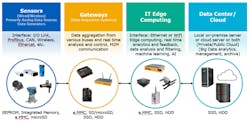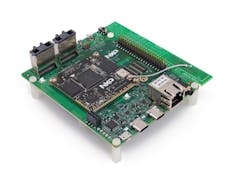Storage Should Not Be an Afterthought in Industrial Design
The fourth wave of the Industrial Revolution, known as Industry 4.0, is ushering in new opportunities for “connected everything,” allowing companies to utilize networked data from sensors, monitors, robots, and other IoT devices to take advantage of artificial intelligence (AI) and machine learning (ML) for more efficient factories. Industry 4.0 has even given birth to completely “lights-out” factories, where minimal-to-no human interaction is needed. In some cases, robots even change batteries on other robots. Because of the desire for smart and automated everything, an entirely new ecosystem of technologies is emerging for industrial IoT (IIoT).
Purpose-built solutions with storage, networking and compute – either in sensors, gateways, at the edge, in the cloud or on-premises – need to be architected in ways that are optimized to for their part in the IIoT ecosystem. As more industrial applications are trained to apply AI and ML algorithms to get real-time actionable insights, the need for versatile and durable storage solutions will continue to increase.
We all know data is growing, and important data must be stored, processed, and analyzed. According to IDC, 90 zettabytes (ZB) of data will be created on IoT devices by 2025.1 Furthermore, Gartner predicts, by 2023, 30% of industrial enterprises will have full, on-premises deployments of IIoT platforms, up from 15% in 2019.2
However, storage, while essential, is often taken for granted, like the oxygen we breathe. Most don’t even think about it, even though we know it’s there. Data can’t thrive without storage. Storage is a key foundational building block and needs to be one of the first design considerations, not one of the last. And here’s why…
Storage Must Keep Pace with Industry 4.0 Trends
Several key trends are driving the need for more storage to support Industry 4.0 IIoT applications.
Computing power moving to the edge and endpoints
The convergence of ubiquitous connectivity and compute capability is fueling exponential growth in connected devices and connected sensors, generating incredible volumes of data and enabling vast new types of transformative applications and business models. This evolution to connected devices means more computing power is moving to the edge and endpoints as IIoT devices can analyze data and act on the results in real time. Industry sources say that by 2021, the amount of data stored on devices will be 4.5 times higher than data stored in data centers.3 In addition, by 2021, machine-to-machine (M2M) will make up more than half of the total IoT connections.4
More machines than ever before
From factory automation to digital signage to smart cities, IIoT relies on more machines these days. In fact, machine data is expected to outpace commercial/consumer data. By 2023, over 90% of data created will be generated by machines,1 which means IT architecture must be prepared accordingly. Whether it’s a robotic arm in a factory or a drone monitoring agricultural fields, these machines require the right storage for the deluge of data they will generate, process, and consume.
The rise of 5G
5G, at 100 times the speed of 4G/LTE, promises to increase bandwidth, reduce latency, and enable brand new applications that revolutionize our current business practices. At the same time, 5G will also introduce new system challenges when it comes to real-time processing. It will make it possible to process, store, and analyze data right at the endpoints as well as at the edge, whether using pattern recognition at a large public venue or camera-based inspection of goods in factory settings. As bandwidth increases, so must storage.
While 5G solves bandwidth issues, it will also impose more stringent requirements on data management that storage interfaces haven’t dealt with in the past. To enable all of the new high-performance, low-latency 5G applications, it will require an updated storage architecture so that hardware components don’t become a data bottleneck.
Winning in IIoT: Consider Storage First
As these Industry 4.0 trends drive the need for more data, there are several key considerations for storage in an IIoT application:
- Environment: In what kind of environment will the data be captured and kept? The most critical environmental conditions that can affect storage performance and reliability are the altitude, temperature, humidity, and vibration. Systems in the mountains at high altitude, or aboard a highspeed train, will need to be resistant to different factors—pressure and movement. Ensure that the storage you select is designed to work and operate in its intended conditions, and environments will be critical to your future operations.
- Endurance: How many times can you write to the storage? With the new workloads enabled by more connected devices, it’s essential that the storage supporting them can sustain continuous read and write for a prolonged period of time. There’s a difference between “Endurance” and “Performance.” For your IIoT applications, the higher the endurance, the longer the product will last. Higher endurance will reduce the amount of maintenance by withstanding the constant write and erase cycles for many more hours compared to commercial and consumer-grade products. In addition, if your equipment is in a hard-to-reach place, such as on the outside of a tall building, a high-endurance storage solution will help reduce the frequency of maintenance and replacement.
- Data retention: How long does the data need to be stored? What do you want to process, analyze, and save at the endpoints, closer to the edge, and in the cloud? Data stored on industrial devices may need to be retained for longer periods of time, such as seasonal temperature patterns for agricultural or weather applications. Therefore, the ability to store and process more data with extended data retention may be critical. Specific data may also be retained in the cloud or on-premises for future analytics. It’s not just the data generated, but also the data that’s essential for the uptime of devices. The storage solution needs to easily scale to meet growing demand as well as potential data-retention policies and capacities required for various applications/use cases.
- Remote health monitoring: How frequently are you able to access the storage in your industrial device? In the IIoT, devices aren’t always easily accessible. In a lights-out factory or remote location, IIoT devices can predict any equipment defects before they occur so that the factory can proactively address the issue before it impacts manufacturing time or, worse, causes downtime. The ability to monitor the health status of storage and perform predictive maintenance on both devices and the storage supporting them will reduce downtime of IIoT applications.
How to Design for IIoT in the Early Stages
Not only must developers think about the unique environments of industrial applications when planning for storage, they also must think about storage early in the process. Many industrial and IoT designs start from a system-on-module (SoM) or single-board computer (SBC), allowing for faster time-to-market and ease of design. These SoMs and SBCs normally use an embedded MultiMediaCard (e.MMC) for the operating system storage; the end application can change the storage capacity based on requirements.
As an example, Western Digital collaborates with ecosystem partners such as NXP to enable solutions for industrial and IoT markets. Platforms like the i.MX 8M EVK compute module deliver high performance with power efficiency, multimedia, and connectivity to accelerate the design and implementation of industrial and IoT devices. Western Digital’s industrial storage products are qualified and compatible with industrial-grade e.MMC embedded flash drives currently used in multiple NXP i.MX8 eval kits and reference designs.
Collaborating with partners such as NXP as well as Renesas helps enable comprehensive products and applications to meet the need for demanding smart and advanced manufacturing environments.
Storage Can’t Be an Afterthought
In the past, storage might have been acquired solely based on anticipated capacity needs or price. However, the autonomous applications in today’s Industry 4.0 elicit many more considerations. With the unique needs of IIoT, architects must plan proactively as they design for qualification, or they risk time-to-market advantage. To support Industry 4.0’s evolution to a more connected world, storage must be a central focus when designing industrial applications due to the variety of storage devices.
Not all storage devices are born alike—it’s not just the interface, but how the devices are architected to meet system requirements. Design considerations such as environment, endurance, remote maintenance, and data retention are critical to meet IIoT system requirements.
Yaniv Iarovici is the Marketing Director of Industrial, IoT, and Edge at Western Digital.
References
1. Applied Materials’ SEMICON West AI Design Forum (July 2019)
2. Gartner Magic Quadrant for Industrial IoT Platforms (June 2019)
3. Cisco Global Cloud Index (Feb. 2018)
4. Cisco, The Zettabyte Era (June 2017)
About the Author
Yaniv Iarovici
Marketing Director of Industrial, IoT and Edge, Western Digital Corp.
Yaniv Iarovici is the Marketing Director of Industrial, IoT, and Edge at Western Digital. A 20-year veteran with a diverse background in software, business development, and product marketing in the high-tech industry, Yaniv has been with Western Digital for over 14 years holding various engineering and marketing roles. Yaniv is responsible for developing go-to-market strategies for storage solutions targeting the industrial and IoT segments. He also oversees the ecosystem development for mobile, automotive, edge-compute and industrial/IoT markets.
Before joining Western Digital Corp., Yaniv held engineering and management positions at M-Systems. Prior to that, he was a software engineer at IAI (Israeli Aerospace Industries) and Friendly Robotics.
Yaniv holds a Bachelor’s in Mathematics and Computer Science.


